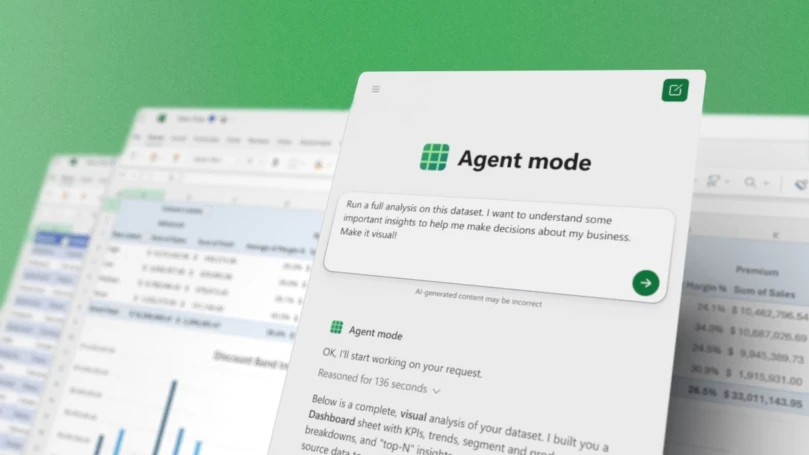Microsoft’s “Vibe Working” Brings AI Collaboration to Office Apps
Microsoft is pioneering a new approach to productivity called “vibe working,” expanding on the concept of “vibe coding” that has gained popularity in tech circles. While vibe coding allows non-developers to create programs by describing what they want and letting AI handle the technical implementation, vibe working applies this collaborative human-AI approach to everyday office tasks. The concept centers on a more dynamic relationship between users and AI assistants, where artificial intelligence doesn’t just respond to commands but actively participates in an ongoing dialogue to generate, test, and refine content while humans guide the overall direction. This shift represents a fundamental change in how we might interact with productivity software in the future, moving from tools we control to intelligent partners we collaborate with.
At the heart of Microsoft’s vibe working initiative is the new Agent Mode being introduced to Excel and Word, with PowerPoint support planned for the future. Unlike the one-off assistance provided by earlier AI helpers, Agent Mode enables Copilot to perform complex, multi-step tasks within these applications. In Word, for example, the AI can update entire reports based on new information, while in Excel, it can analyze data sets and create visualizations without requiring users to know specific formulas or chart-building techniques. This functionality is complemented by Office Agent in Copilot chat, which allows users to produce entire PowerPoint presentations or Word documents starting from simple prompts and refining the results through conversation. It’s particularly noteworthy that Office Agent runs on AI models from Anthropic (maker of Claude), signaling Microsoft’s strategic diversification beyond its primary AI partner, OpenAI.
The introduction of these features comes amid an intensifying race in the productivity software market, where AI capabilities have become a crucial competitive differentiator. Google has been steadily enhancing its Workspace apps with generative AI features, while companies like Apple, OpenAI, Anthropic, Canva, and Notion are all developing agent-style AI systems for various business and creative applications. Microsoft’s aggressive push into this space makes strategic sense given the financial importance of its productivity offerings—Microsoft 365 Commercial products and cloud services generated an impressive $87.8 billion in revenue in fiscal year 2025, representing 14% growth and standing as the company’s second-largest business segment behind only its server products and cloud services.
What makes vibe working particularly interesting is how it redefines the relationship between humans and their software tools. Traditional productivity software required users to learn specific commands, interfaces, and workflows to accomplish tasks. Even earlier AI assistants like the original Copilot primarily offered suggestions or executed discrete commands. The new agent-based approach creates a more collaborative dynamic where the AI can take initiative, suggest alternatives, and handle complex processes while the human provides guidance, evaluates results, and makes strategic decisions. This partnership leverages the respective strengths of both human and artificial intelligence—humans excel at understanding context, making judgment calls, and providing creative direction, while AI excels at processing large amounts of information, generating options, and executing technical tasks consistently.
For everyday users, these developments could significantly lower the barriers to creating professional-quality documents, sophisticated data analyses, and compelling presentations. Someone with limited Excel skills could ask the AI to analyze survey data and create visualizations that highlight key trends. A marketing professional could describe the content and style they want for a presentation, then refine it through conversation rather than manually building slides. A manager could ask for a comprehensive report that incorporates the latest financial data, customer feedback, and market research without having to compile and format this information manually. These capabilities could democratize access to professional-quality content creation, similar to how smartphone cameras with computational photography have allowed amateurs to take photos that once required professional equipment and expertise.
As with any technological shift, Microsoft’s rollout of these features is gradual and strategic. Agent Mode is initially available as a preview for Microsoft 365 Copilot and Microsoft 365 Personal or Family subscribers through the company’s Frontier program, with web versions coming first and desktop applications to follow. Office Agent has an even more limited initial release, available only to Personal and Family users in the United States. This phased approach allows Microsoft to gather feedback, refine the technology, and address any issues before wider deployment. It also gives the company time to consider important questions around privacy, security, and appropriate use cases—concerns that are particularly important when dealing with business documents that may contain sensitive information. As these features mature and become more widely available, they may well reshape how millions of people interact with the productivity tools that have become essential to modern work life.















